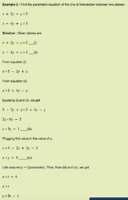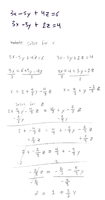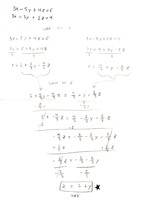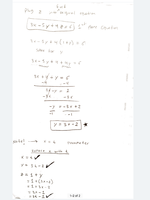You are using an out of date browser. It may not display this or other websites correctly.
You should upgrade or use an alternative browser.
You should upgrade or use an alternative browser.
Find the line of intersection of planes
- Thread starter Gavriell
- Start date
mmm4444bot
Super Moderator
- Joined
- Oct 6, 2005
- Messages
- 10,902
I tried to follow this method to find the line of intersection

This is what I have right now but, I feel that i'm doing something wrong, as in the example above we don't have any coefficient for the x variable, on the other hand, the problem that I'm trying to solve has 3x. This makes me think that there is something else I have to do.


This is what I have right now but, I feel that i'm doing something wrong, as in the example above we don't have any coefficient for the x variable, on the other hand, the problem that I'm trying to solve has 3x. This makes me think that there is something else I have to do.

HallsofIvy
Elite Member
- Joined
- Jan 27, 2012
- Messages
- 7,763
Okay, you solve the two equation for x, in terms of y and z, and, setting those equal, get \(\displaystyle 2+ \frac{5}{3}y- \frac{4}{3}z= \frac{4}{3}+ y- \frac{2}{3}z\). That's correct. You then solve for z, in terms of y, first by subtracting \(\displaystyle \frac{5}{3}y\) from both sides. That's where you make your mistake. On the right, you have y and subtract \(\displaystyle \frac{5}{3}y\) from that. That is \(\displaystyle \left(1- \frac{5}{3}\right)y= \left(\frac{3}{3}- \frac{5}{3}\right)y= -\frac{2}{3}y\) but in your next line you have just \(\displaystyle -\frac{5}{3}y\). Then subtracting 2 from both sides, you should have \(\displaystyle -\frac{2}{3}z= \frac{2}{3}- \frac{2}{3}y\) (again that is 2/3 times y, not 5/3).
Finally, dividing both sides by \(\displaystyle -\frac{2}{3}\), \(\displaystyle z= -1+ y\).
Putting that into the original equation of the first plane, \(\displaystyle 3x- 5y+ 4z= 3x- 5y+ 4(y- 1)= 3x- y- 4= 6\) or \(\displaystyle y= 3x+ 2\). Since I don't like fractions I will use x rather than y as parameter: x= t, y= 3t+ 2, z= y-1= 3t+ 2-1= 3t+ 1.
Finally, dividing both sides by \(\displaystyle -\frac{2}{3}\), \(\displaystyle z= -1+ y\).
Putting that into the original equation of the first plane, \(\displaystyle 3x- 5y+ 4z= 3x- 5y+ 4(y- 1)= 3x- y- 4= 6\) or \(\displaystyle y= 3x+ 2\). Since I don't like fractions I will use x rather than y as parameter: x= t, y= 3t+ 2, z= y-1= 3t+ 2-1= 3t+ 1.
Otis
Elite Member
- Joined
- Apr 22, 2015
- Messages
- 4,414
Hello. Don't be concerned about the coefficients; the coefficients can be any Real numbers. (Also, you solved each of the given equations for x, so you don't have 3x anymore.)… in the example above we don't have any coefficient for the x variable, on the other hand, the problem that I'm trying to solve has 3x.
Your work looks good, so far, but you made a mistake in solving for z, by proceeding with \(y - \frac{5}{3}y = -\frac{5}{3}y\).
After you correct that mistake (above), there's a more-direct way to solve for z in your last section. Start by moving all the z-terms to one side and everything else to the other side. Next, combine like-terms. Then multiply each side by the reciprocal of the resulting coefficient on z. If I did it correctly, the third step looks like this:
\(\displaystyle \bigg(-\frac{3}{2}\bigg)\cdot\bigg(-\frac{2}{3}z\bigg) = \bigg(-\frac{3}{2}\bigg)\cdot\bigg(-\frac{2}{3} - \frac{2}{3}y\bigg)\)
?
pka
Elite Member
- Joined
- Jan 29, 2005
- Messages
- 11,971
The cross product \(\displaystyle \left\langle {3, - 5,4} \right\rangle \times \left\langle {3, - 3,2} \right\rangle=\left\langle {2,6,6} \right\rangle\) is the direction of the line \(\displaystyle k\)
So the line parallel to \(\displaystyle k\) through \(\displaystyle (-7,4,1)\) is
\(\displaystyle l(t) = \left\{ \begin{array}
2t - 7\\
6t + 4\\
6t + 6
\end{array} \right.\)
Okay, you solve the two equation for x, in terms of y and z, and, setting those equal, get \(\displaystyle 2+ \frac{5}{3}y- \frac{4}{3}z= \frac{4}{3}+ y- \frac{2}{3}z\). That's correct. You then solve for z, in terms of y, first by subtracting \(\displaystyle \frac{5}{3}y\) from both sides. That's where you make your mistake. On the right, you have y and subtract \(\displaystyle \frac{5}{3}y\) from that. That is \(\displaystyle \left(1- \frac{5}{3}\right)y= \left(\frac{3}{3}- \frac{5}{3}\right)y= -\frac{2}{3}y\) but in your next line you have just \(\displaystyle -\frac{5}{3}y\). Then subtracting 2 from both sides, you should have \(\displaystyle -\frac{2}{3}z= \frac{2}{3}- \frac{2}{3}y\) (again that is 2/3 times y, not 5/3).
Finally, dividing both sides by \(\displaystyle -\frac{2}{3}\), \(\displaystyle z= -1+ y\).
Putting that into the original equation of the first plane, \(\displaystyle 3x- 5y+ 4z= 3x- 5y+ 4(y- 1)= 3x- y- 4= 6\) or \(\displaystyle y= 3x+ 2\). Since I don't like fractions I will use x rather than y as parameter: x= t, y= 3t+ 2, z= y-1= 3t+ 2-1= 3t+ 1.
Thank you! This is my final results, by the way the part where you say “Finally, dividing both sides by \(\displaystyle -\frac{2}{3}\), \(\displaystyle z= -1+ y\).” I think it should be \(\displaystyle -\frac{2}{3}\), \(\displaystyle z= 1+ y\).




